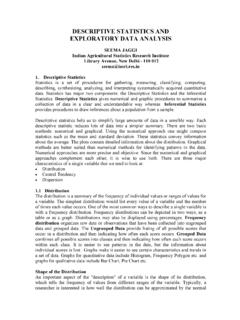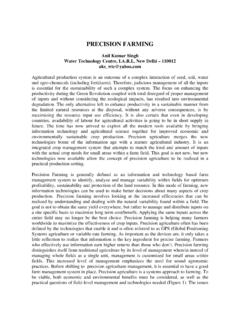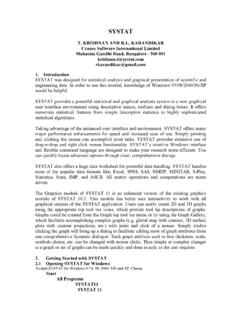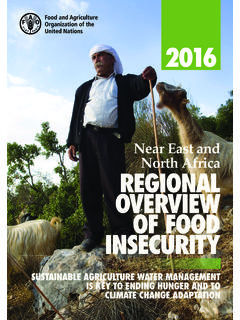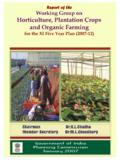Transcription of Indian Agricultural Statistics Research Institute: A Profile
1 Indian Agricultural Statistics Research institute : A Profile Gupta, Bhatia and Rajender Parsad 1. Historical Development IASRI has been and continues to be a premier institute of the ICAR with glorious tradition of carrying out Research , teaching and training in the areas of Agricultural Statistics and Computer Application. Recognizing the importance of Research and education in Agricultural Statistics way back in 1930, the then Imperial Council of Agricultural Research established a small Statistical Section to assist the State Departments of Agriculture and Animal Husbandry in planning and designing their experiments, analysing the experimental data, interpreting the results, rendering advice on the formulation of the technical programmes and examining the progress reports of the schemes funded by the Council.
2 The statistical section was headed by a statistician and Late Shri M. Vaidyanathan was the first statistician of the statistical section. The Research activities of the statistical section took a big leap with the appointment of Late Dr. PV. Sukhatme as statistician in 1940. Basic Research in the theory of Statistics was undertaken to bridge the gaps in the available methodologies for solving practical problems in Agricultural Research . With an expansion in its scope and Research activities being undertaken, the statistical section was re-organised as the Statistical Branch in 1945 with associated expansion in its strength. The statistical branch was headed by a Statistical Advisor. The advisory work relating to agriculture and animal husbandry was separated into two units, each under the charge of a statistician.
3 A new dimension was added to the activities of the statistical section towards the end of 1943 when the enquiry committee set up by the Government of India to enquire into the causes of the Bengal famine came to the conclusion that one of the main factors responsible for the famine was the inappropriate Statistics of crop production available at that time. As desired by Government of India and the ICAR, the statistical section undertook Research in the methods of collection of yield Statistics of crops by developing techniques for yield estimation based on the methods of random sampling. In the course of this work the statistical section also undertook Research in sampling theory and imparted practical training to the field staff in different States.
4 The work involved in scrutiny, compilation and analysis of the voluminous data collected in the crop cutting surveys was immense and the activities of the statistical branch were ever mounting. An important development that took place in 1945 was the initiation of two regular certificate courses, one course of six months duration, called Junior Certificate Course (JCC) and the other course of one year duration called Senior Certificate Course (SCC). Besides, there was another course of one year duration that was introduced to train professional statisticians. Subsequently, a Diploma course involving a Research project of one year duration, in addition to the Professional Statisticians' Certificate Course (PSCC) consisting of one year course work in advanced Statistics , was also introduced.
5 This necessitated the augmentation of the staff and accordingly, the strength of the branch was increased to two Professors of Statistics and other staff. These certificate courses helped in strengthening the linkages of the institute IASRI An era of excellence with the state departments of agriculture and animal husbandry. The certificate courses started in 1945. were discontinued by the Indian Council of Agricultural Research (ICAR) in 1985-86. However, during 1997, the Senior Certificate Course in Agricultural Statistics and Computing' was revived. This course is now of six months duration and lays more emphasis on statistical computing using statistical software. The course was divided into two modules viz. (i) Statistical Methods and Official Agricultural Statistics , and (ii) Use of Computers in Agricultural Research , of three months duration each.
6 The period 1945-49 was one of intensive activities in the statistical branch when under its technical guidance, yield estimation surveys were carried out in almost all the States covering Wheat and Rice crops. By 1949, the results of sample surveys were also being used for official forecasts. Gradually these surveys were extended to other crops such as Jowar, Bajra, Maize and Cotton. The statistical branch was renamed as Statistical Wing in 1949. In 1951, Late Dr. PV Sukhatme moved to FAO as Chief, Statistics Branch, Rome. Late Dr. VG Panse took over as Statistical Advisor of the Council in 1951. The Statistical Wing soon acquired the international recognition as a Centre of Research and Training in the field of Agricultural Statistics .
7 Subsequently, in recognition of the important role as a training and Research institution and based on the recommendations of two FAO experts Dr. Frank Yates and Dr. DJ Finney, the Statistical Wing was re-designated as the institute of Agricultural Research Statistics (IARS) on 02 July 1959. In 1966 on retirement of Late Dr. VG Panse, Late Dr. GR. Seth took over as statistical advisor. In April 1970, the IARS was given the status of a full fledged institute of the ICAR headed by a Director with Late Dr. GR Seth as the first Director. On 01 January 1978 the name of the institute was changed to Indian Agricultural Statistics Research institute (IASRI). emphasizing the role of Agricultural Statistics as a full fledged discipline by itself.
8 In 1955, the statistical wing moved to its present campus. The building provided adequate space for library, reading rooms, lecture halls, auditorium and office for its technical and ministerial staff. A hostel with modern amenities was constructed for the trainees. Collaboration with the All India Co-ordinated Agronomic Experiments Research Projects of the ICAR started in 1956. This project consisted of two components viz., (a) complex experiments conducted at Research centres, and (b) simple experiments conducted on cultivators' fields. A mechanical data processing unit was added to the institute in 1957. The year 1964 witnessed tremendous changes in the activities of the institute . An MOU was signed with IARI, New Delhi to start new degree courses leading to and in Agricultural Statistics .
9 In 1981, a two years Diploma Course in Advanced Computer Programming was introduced. On the recommendations of UNDP, this course was soon discontinued and in 1985 another new course leading to an degree in Computer Applications in Agriculture was initiated in collaboration with IARI, New Delhi. This course was redesignated as degree in Computer Application during 1993-94. The institute has so far produced 173 and 287 students in Agricultural Statistics and 81 students in Computer Application. The alumni of the institute are at present occupying high positions in Universities and other academic Research institutions of USA, Canada and other countries. During 1964, yet another mile stone was the installation of an IBM 1620 Model II electronic computer.
10 In 1977, the IBM 1620 computer was replaced with a third generation computer Burroughs B-4700. The institute has always kept pace with the latest state-of-the-art-technologies. In 1991 the Burroughs B- 4700 was replaced by a Super Mini COSMOS LAN SERVER. The LAN and Intranet were further strengthened with Fibre optics and UTP cabling and at present LAN is supporting all the three buildings 2. Indian Agricultural Statistics Research institute : A Profile of the institute and almost every scientist has a PC on the work table. With the advent of LAN Server and PCs, Divisional computing Labs were created. A Remote Sensing and GIS Lab with latest software facilities was established. A Statistics Lab has been created very recently in which almost all the software are available on the PCs.

